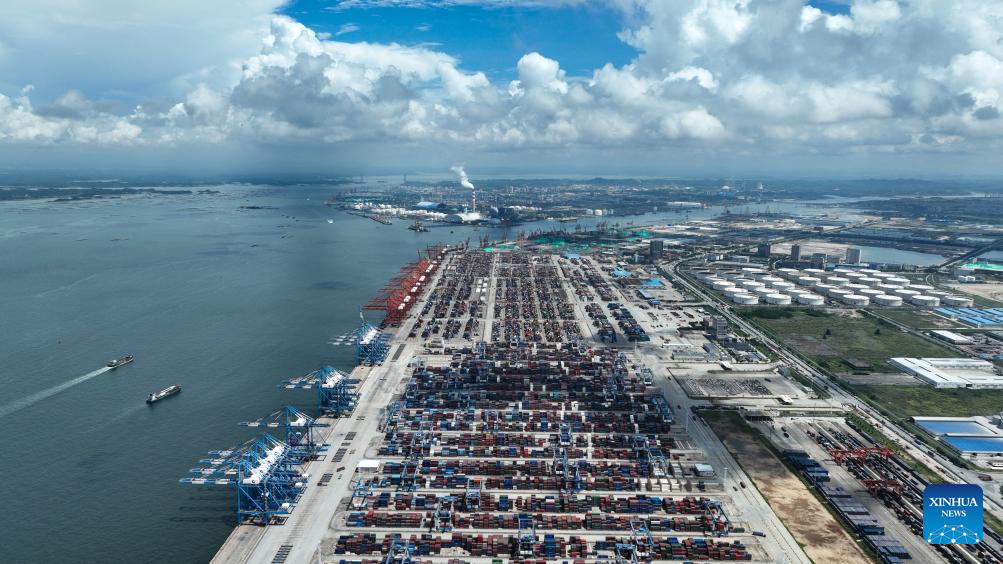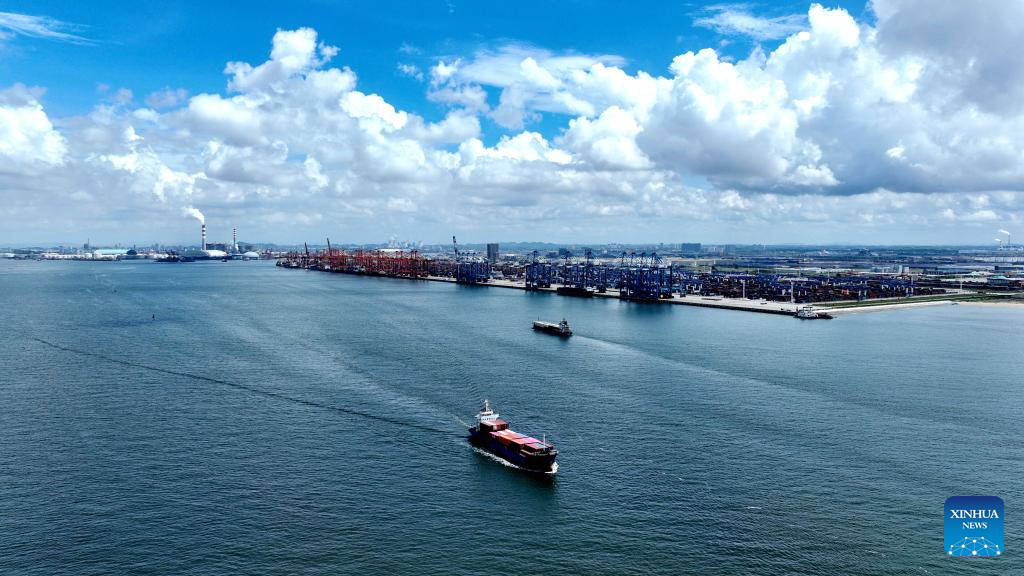
An aerial drone photo taken on July 3, 2025 shows an ocean vessel fully loaded with containers docking at an automated container terminal of Qinzhou Port, in Qinzhou City, south China's Guangxi Zhuang Autonomous Region. Cargo volume on the New International Land-Sea Trade Corridor surged 76.9 percent year on year to 746,000 twenty-foot equivalent units (TEUs) in the first six months of this year, according to the China Railway Nanning Group. The corridor now operates 14 fixed train routes connecting Beibu Gulf Port in Guangxi and Zhanjiang Port in neighboring Guangdong Province to major inland hubs including Chongqing, Chengdu, Guiyang, Lanzhou, Huaihua and Xi'an. Goods transported through the trade corridor via intermodal rail-sea service now cover 1,236 categories, 79 more than a year earlier, spanning electronics, vehicles and auto parts, machinery, household appliances, and food. (Xinhua/Zhang Ailin)

An aerial drone photo taken on July 3, 2025 shows a view of Qinzhou Port in Qinzhou City, south China's Guangxi Zhuang Autonomous Region. Cargo volume on the New International Land-Sea Trade Corridor surged 76.9 percent year on year to 746,000 twenty-foot equivalent units (TEUs) in the first six months of this year, according to the China Railway Nanning Group. The corridor now operates 14 fixed train routes connecting Beibu Gulf Port in Guangxi and Zhanjiang Port in neighboring Guangdong Province to major inland hubs including Chongqing, Chengdu, Guiyang, Lanzhou, Huaihua and Xi'an. Goods transported through the trade corridor via intermodal rail-sea service now cover 1,236 categories, 79 more than a year earlier, spanning electronics, vehicles and auto parts, machinery, household appliances, and food. (Xinhua/Zhang Ailin)

An aerial drone photo taken on July 3, 2025 shows a container yard of an automated container terminal of Qinzhou Port in Qinzhou City, south China's Guangxi Zhuang Autonomous Region. Cargo volume on the New International Land-Sea Trade Corridor surged 76.9 percent year on year to 746,000 twenty-foot equivalent units (TEUs) in the first six months of this year, according to the China Railway Nanning Group. The corridor now operates 14 fixed train routes connecting Beibu Gulf Port in Guangxi and Zhanjiang Port in neighboring Guangdong Province to major inland hubs including Chongqing, Chengdu, Guiyang, Lanzhou, Huaihua and Xi'an. Goods transported through the trade corridor via intermodal rail-sea service now cover 1,236 categories, 79 more than a year earlier, spanning electronics, vehicles and auto parts, machinery, household appliances, and food. (Xinhua/Zhang Ailin)

An aerial drone photo taken on July 3, 2025 shows an ocean vessel fully loaded with containers leaving Qinzhou Port, in Qinzhou City, south China's Guangxi Zhuang Autonomous Region. Cargo volume on the New International Land-Sea Trade Corridor surged 76.9 percent year on year to 746,000 twenty-foot equivalent units (TEUs) in the first six months of this year, according to the China Railway Nanning Group. The corridor now operates 14 fixed train routes connecting Beibu Gulf Port in Guangxi and Zhanjiang Port in neighboring Guangdong Province to major inland hubs including Chongqing, Chengdu, Guiyang, Lanzhou, Huaihua and Xi'an. Goods transported through the trade corridor via intermodal rail-sea service now cover 1,236 categories, 79 more than a year earlier, spanning electronics, vehicles and auto parts, machinery, household appliances, and food. (Xinhua/Zhang Ailin)
(Source: Xinhua)
